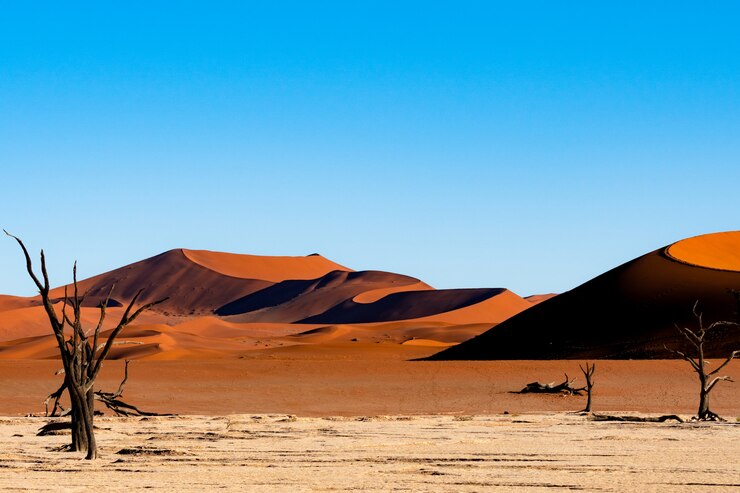The Namib Desert, a vast stretch of arid land bordering the Atlantic Ocean, holds a special place in the hearts and minds of Namibians and people around the world. Its striking landscapes, which include towering sand dunes, rocky plains, and dry riverbeds, have not only shaped the natural environment of the region but have also been pivotal in shaping Namibia’s identity and its very name. The story of how the Namib Desert influenced Namibia’s naming and cultural identity is one of deep historical and geographical significance.
In this article, we will explore the role of the Namib Desert in Namibia’s identity, from its origins and geological importance to its role in the country’s culture, history, and independence. We will also uncover how the desert gave rise to the name “Namibia” and why it remains such an integral part of the country’s national consciousness.
1. Understanding the Namib Desert: A Natural Wonder
The Namib Desert is one of the oldest deserts in the world, estimated to be around 55 million years old. Its name, “Namib,” is derived from a Khoisan word that means “vast place” or “a place where there is nothing.” The desert stretches over 2,000 kilometers along the Atlantic coast, encompassing much of Namibia’s western region. It extends into parts of Angola and South Africa, but its most famous and dramatic features lie within Namibian borders.
The desert is known for its towering red dunes, some of which reach heights of over 300 meters, making them the highest in the world. The Namib Desert is also home to unique geological formations such as the ghost town of Kolmanskop, the ancient rock engravings at Twyfelfontein, and the otherworldly landscapes of Deadvlei, where dry, cracked earth contrasts with the striking white skeletons of acacia trees. Despite its harsh environment, the desert is home to an array of unique wildlife, including adapted species like the oryx, springbok, and desert-adapted elephants.
2. The Namib Desert and the Origins of Namibia’s Name
The name “Namibia” can be traced directly to the Namib Desert. Prior to gaining independence, the country was known as South West Africa, a name it carried during its colonization by Germany and later under South African administration. However, after Namibia’s long and hard-fought battle for independence from apartheid-era South Africa, the country needed a name that symbolized its sovereignty, unity, and deep connection to its land.
In 1990, when Namibia achieved independence, it chose to adopt the name “Namibia” as a reflection of its identity. The name was directly inspired by the Namib Desert, which forms a significant part of the country’s natural geography. The decision to name the country after the desert was symbolic, as the desert’s vastness and endurance reflected the struggles and resilience of the Namibian people throughout history.
The name also reflected a broader cultural and historical significance. The Namib Desert, a landmark feature of the country’s western landscape, was the backdrop for the indigenous groups of Namibia, including the Khoikhoi and the San, whose ancestors had lived in the region for thousands of years. By naming the country after the desert, the people of Namibia were able to recognize their deep-rooted relationship with the land, an enduring connection that shaped their heritage and history.
3. The Role of the Namib Desert in Shaping Namibia’s Identity
The Namib Desert is more than just a natural landmark; it has profoundly shaped Namibia’s identity, from the physical landscape to the cultural psyche of its people. It is the backdrop for much of the country’s history and continues to play an important role in modern-day Namibia.
The Desert and Indigenous Culture
For millennia, the Namib Desert has been home to various indigenous groups, including the San (Bushmen), the Himba, and the Nama people. These groups have learned to adapt to the harsh conditions of the desert, developing traditional knowledge systems that allowed them to thrive in the unforgiving environment. The San, for example, are known for their expertise in hunting and gathering, while the Himba people have been successful in livestock herding in the arid conditions of the desert regions. The Nama people, who are closely related to the Khoikhoi, also have a long history in the desert areas of Namibia.
For these communities, the Namib Desert was not just a physical location, but a source of spiritual and cultural identity. The desert played a central role in their beliefs, customs, and ways of life, and it remains an integral part of their heritage today. The Namib Desert, with its vast emptiness and beauty, continues to inspire poetry, music, and art, as well as spiritual connection to the land.
Namibia’s National Identity
As Namibia transitioned into a democratic and independent nation, the desert became a symbol of national pride and unity. The Namib Desert represents the struggle and perseverance of a people who have weathered centuries of colonialism, apartheid, and oppression, and it continues to be a beacon of hope and resilience for Namibians. The country’s connection to the Namib Desert is symbolic of the strength and endurance of the people, who have emerged from a difficult past into a new era of freedom and self-determination.
4. The Desert’s Economic Significance
In addition to its cultural and historical importance, the Namib Desert plays a vital role in Namibia’s economy. The desert’s natural resources, including minerals, wildlife, and tourism, contribute significantly to the country’s economic development.
Mining and Natural Resources
Namibia is rich in natural resources, and the Namib Desert is home to some of the world’s most valuable mineral deposits. The desert region is known for its vast salt pans, diamond deposits, and uranium mines, all of which have been significant contributors to Namibia’s economy. Diamond mining in the Namib Desert, particularly along the Skeleton Coast, has been a major source of income for the country, while uranium mining in the desert regions is also a key sector in Namibia’s growing mining industry.
The desert’s mineral wealth has not only shaped Namibia’s economy but also attracted international attention and investment. However, the country is committed to ensuring that the exploitation of its natural resources is done sustainably and responsibly, in a way that protects the environment and benefits local communities.
Ecotourism and the Desert’s Beauty
Tourism is another critical industry that benefits from the Namib Desert’s allure. As one of the most iconic deserts in the world, the Namib Desert draws tourists from around the globe who are eager to explore its unique landscapes. The desert is home to several major tourist attractions, including Sossusvlei, Deadvlei, and the Namib-Naukluft National Park. These sites, with their striking dunes, ancient trees, and dramatic vistas, are among the most photographed and visited locations in Africa.
Ecotourism in the Namib Desert provides a sustainable source of income for local communities and helps raise awareness about the importance of preserving Namibia’s unique natural heritage. The country’s commitment to conservation and responsible tourism ensures that the beauty of the Namib Desert will continue to be enjoyed by future generations, while also contributing to the livelihoods of Namibians living in and around the desert regions.
The Namib Desert is much more than a physical feature of Namibia’s landscape; it is a powerful symbol of the nation’s identity, culture, and resilience. From its early inhabitants to its modern-day role in the economy, the desert has shaped Namibia in profound ways. The decision to name the country after the desert was a deliberate act of reclaiming a unique cultural and historical connection to the land, reflecting the spirit of unity and strength that defines Namibia today.
As Namibia continues to grow and develop, the Namib Desert will remain an enduring symbol of the country’s past, present, and future. It is a place that holds the stories of the people, the land, and the struggle for freedom, and its legacy will continue to define Namibia for generations to come. Whether through the desert’s natural beauty, its economic resources, or its spiritual and cultural significance, the Namib Desert will always be at the heart of Namibia’s identity.
Join 'Namibia Today' WhatsApp Channel
Get the breaking news in Namibia — direct to your WhatsApp.
CLICK HERE TO JOIN












